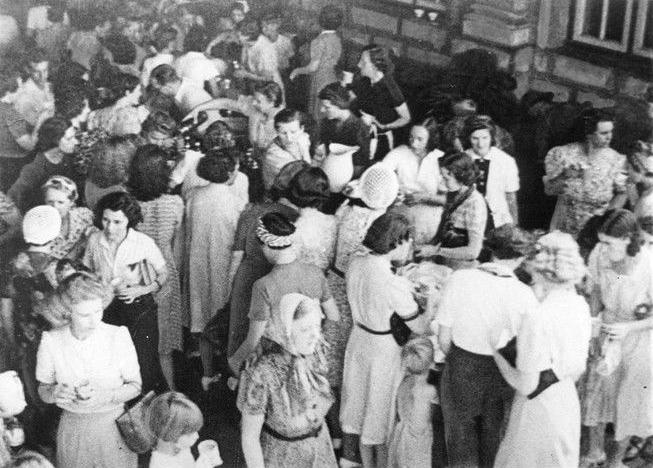
World War II Country Trends: Malaya--British Civilians

Figure 1.--The Japanese began landing in the Malay Peninsula immediatly fter Pearl Harbor (December 8, 1941). Civilians were surprised thatg the British military forces proved unable to contain the numerically smaller and poorly supplied Japanese invasion force. Civilians began evacuating to the south toward the Singapore bastion. Here is a press report about the ongoing evacuation. The public in Britain and America were stunned with the Japanese successes. The caption read, "Swept Down Malaya by Jap Tide: In their haste yo leave their homes in and near Penang, Malya, British refugees crowd an evacuatiomn depot for departure to safety in the south and the protection of the Singapore defenses. Here they have arrived at Ipon by train. Here part of the group wait to find out the next move on their trek to safety." The photo was released by the AP on February 5, 19o42. It was prbably taken a few days earlier. The Japanese created a submarine base at Penang which German and Italian submarines also used.
|
|
The English Channel stopped the Panzers meaning that the British except for the Channel Islanders were spared the horrors of a NAZI occupation. British and Australian subjects in Asia were not so fortunate. The first to be seized by the Japanese were in Shanghai and Hong Kong, days after Pearl Harbor. Some had left before the Japanese struck, knowing that the Japanese Army was just outside the gates of the Shanghai Shanhai International Settlement and the Hong Kong Crown Colony. Many did not leave and were interned by the Japanese. In Hong Kong immediately, in Shanghai later. The British in Malaya felt more secure. They were not surrounded by the Japanese and there were subtantial British and Empire forces both in Malaya as well a the 'impregnanle' Singapore bastion. We are not entitrely sure just what the civilians were involved with. we think most of the Peninsula were operating rubber plantations. On Singapore itself, their functions were more diverse. Few civilians on the Peninsula or on Singapore knew knew how badly prepared or equipped the British forces in Malaya and Singapore were to face the Japanese. The lack of seriouness among the British can be seen of the British lack of seriousness was that 2 years into the War and the despite the fact that it was know that the Japanese were preparing to go to war, the authorities not only made few defensive preparatyions, but did not even begin preparing the civilians. There was not even any food rationing. Japanese landings in the nort began immeditely affter Pearl Harbor (August 8, 1941). The civilians in Malaya mostly escaped to Singapore and with the fall of the city were interned there. Like the British in Hong Kong, the British civilians in Malaya and Singapore were interned immediately. We are not sure about the numbers, but seem to be about 4,000 men, women, and children, not including, however, the much larger numbers of POWs. I think this number includes Australians, but am not positive. Non-European civilians brought the total to over 4,500 civilians.
CIH -- WW II

Navigate the CIH World War II Section:
[Return to Main British refugee: Far East page ]
[Return to Main Japanese conqest of Malaya page ]
[Return to Main World War II M-Z country page ]
[Biographies]
[Campaigns]
[Children]
[Countries]
[Deciding factors]
[Diplomacy]
[Geo-political crisis]
[Economics]
[Home front]
[Intelligence]
[POWs]
[Resistance]
[Race]
[Refugees]
[Technology]
[Totalitarian powers]
[Bibliographies]
[Contributions]
[FAQs]
[Images]
[Links]
[Registration]
[Tools]
[Return to Main World War II page]
[Return to Main war essay page]
[Return to CIH Home page]
Created: 12:09 AM 1/9/2017
Last updated: 12:09 AM 1/9/2017



